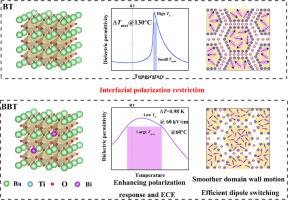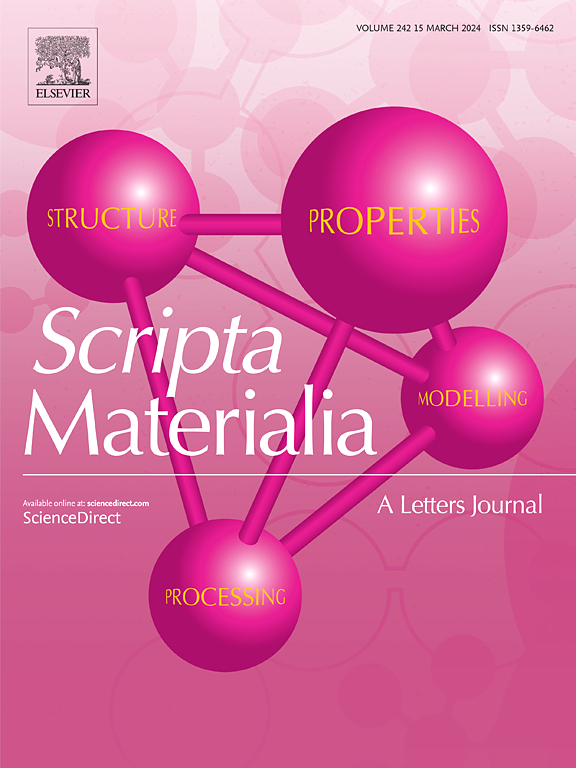Enhanced electrocaloric effect in lead-free ceramics through interfacial polarization restriction
IF 5.6
2区 材料科学
Q2 MATERIALS SCIENCE, MULTIDISCIPLINARY
引用次数: 0
Abstract
Electrocaloric (EC) refrigeration offers high efficiency, environmental compatibility, and miniaturization for localized and chip-level cooling. Ferroelectric polycrystalline ceramics are ideal EC candidates, but their performance is hindered by interfacial polarization arising from defects and energy barriers at grain boundaries. In this work, Bi3+ was incorporated into BaTiO3 (BT) to restrict interfacial polarization by reducing the activation energy mismatch between grain and grain boundary. The resulting oxygen vacancies (OVs) facilitate charge transfer and transition from localized to diffusive charge states. These effects enhance electric field uniformity and domain switching dynamics, leading to improved polarization response and EC performance. A maximum adiabatic temperature change (ΔT) of 0.98 K was achieved in the 9 mol% Bi2O3-doped BT sample at 60 kV/cm and 60 °C, with ΔT > 0.9 K maintained over 50–95 °C. This study offers a viable route for optimizing EC ceramics through interfacial polarization control.

通过界面极化限制增强无铅陶瓷的电热效应
电热(EC)制冷提供高效率,环境兼容性和小型化的本地化和芯片级冷却。铁电多晶陶瓷是理想的EC候选者,但其性能受到晶界缺陷和能垒引起的界面极化的阻碍。在这项工作中,Bi3+加入到BaTiO3 (BT)中,通过减少晶粒和晶界之间的活化能失配来限制界面极化。由此产生的氧空位(OVs)促进了电荷转移和从局域电荷态到扩散电荷态的转变。这些效应增强了电场均匀性和畴切换动力学,从而改善了极化响应和EC性能。在60 kV/cm和60℃条件下,9mol % bi2o3掺杂的BT样品的最大绝热温度变化(ΔT)为0.98 K,在50-95℃条件下保持ΔT >; 0.9 K。本研究为通过界面极化控制优化EC陶瓷提供了一条可行的途径。
本文章由计算机程序翻译,如有差异,请以英文原文为准。
求助全文
约1分钟内获得全文
求助全文
来源期刊

Scripta Materialia
工程技术-材料科学:综合
CiteScore
11.40
自引率
5.00%
发文量
581
审稿时长
34 days
期刊介绍:
Scripta Materialia is a LETTERS journal of Acta Materialia, providing a forum for the rapid publication of short communications on the relationship between the structure and the properties of inorganic materials. The emphasis is on originality rather than incremental research. Short reports on the development of materials with novel or substantially improved properties are also welcomed. Emphasis is on either the functional or mechanical behavior of metals, ceramics and semiconductors at all length scales.
 求助内容:
求助内容: 应助结果提醒方式:
应助结果提醒方式:


